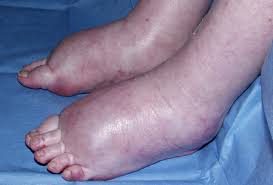Oedema Causes, Symptoms, Diagnosis and Treatment

What is Oedema?
Oedema is a build-up of fluid in the body which causes the affected tissue to become swollen.
The swelling can occur in one particular part of the body or may be more general, depending on the cause.
Fluid can accumulate under the skin most commonly causing swelling of the lower legs and ankles or in one of the body’s internal organs, such as the lungs.
Causes of Oedema
Some of the many common Causes of Oedema include:
- Gravity – standing up for long periods of time allows fluid to ‘pool’ in the tissues of the lower leg.
- Hot weather – the body tends to be less efficient at removing fluid from tissues during the summer months.
- Burns – including sunburn. The skin retains fluid and swells in response to burn injuries.
- Menstrual cycle – some women experience oedema in the two weeks prior to menstruation.
- Pregnancy – hormones encourage the body to hold onto excess fluid.
- The pill – oral contraceptives that include oestrogen can trigger fluid retention.
- Dietary deficiency – such as insufficient protein or vitamin B1 (thiamine) in the diet.
- Medications – certain drugs, including high blood pressure medication (antihypertensives), corticosteroids and nonsteroidal anti-inflammatory drugs (NSAIDs) are known to cause fluid retention.
- Chronic venous insufficiency – weakened valves in the veins of the legs fail to efficiently return blood to the heart. The pooling of blood can result in varicose veins.
Symptoms of Oedema
Symptoms will mainly depend on the underlying cause. The following refer to generalized oedema:
- Swelling of the skin
- Skin may be stretched and shiny
- The skin may retain a dimple after being pressed for about ten seconds
- Puffiness of the ankles, face or eyes
- Aching body parts
- Stiff joints
- Weight gain
- Weight loss
- Hand and neck veins are fuller
- Raised pulse rate
- Hypertension – raised blood pressure
- Ascites – increased abdominal size.
Diagnosis of Oedema
The primary care physician will investigate what the underlying cause of the oedema is. The patient will be asked questions about his/her:
- Medical history
- Current state of health
- How long the signs and symptoms have existed
- How permanent or intermittent the signs and symptoms are
- Whether the patient has had oedema before.
The physician will also carry out a physical exam. If there are indications that there may be an underlying medical condition causing the oedema, the doctor may order some tests. These may include:
- A chest X-ray
- Blood tests
- Urine tests
- Liver function tests
- Heart function tests.
Treatment of Oedema
Oedema is often temporary and clears up by itself. For example, if you’ve been standing up for too long on a hot day, your ankles may swell up until you get the chance to put your feet up and rest.
If oedema doesn’t go away by itself, see your GP. They’ll try and find out if there’s an underlying cause which needs to be treated. This could involve taking medication or following some advice, such as:
- Losing weight (if you’re overweight)
- Taking regular exercise, such as walking, swimming or cycling
- Raising your legs three to four times a day to improve your circulation
- Avoiding standing for long periods of time
If an underlying condition is causing the fluid imbalance, it should clear up after the condition has been diagnosed and treated.
Related Articles:
Melasma Causes, Symptoms, Diagnosis and Treatment
Tinea Pedis Causes, Symptoms, Diagnosis and Treatment
Tinea Faciei Causes, Symptoms, Diagnosis and Treatment
Thrombophlebitis Causes, Symptoms, Diagnosis and Treatment
Thrombocytopenia Causes, Symptoms, Diagnosis and Treatment
Torticollis Causes, Symptoms, Diagnosis and Treatment
Eczema Causes, Symptoms, Diagnosis and Treatment
Toxic Shock Syndrome Causes, Symptoms, Diagnosis and Treatment
Tarsal Cyst Causes, Symptoms, Diagnosis and Treatment
By : Natural Health News




